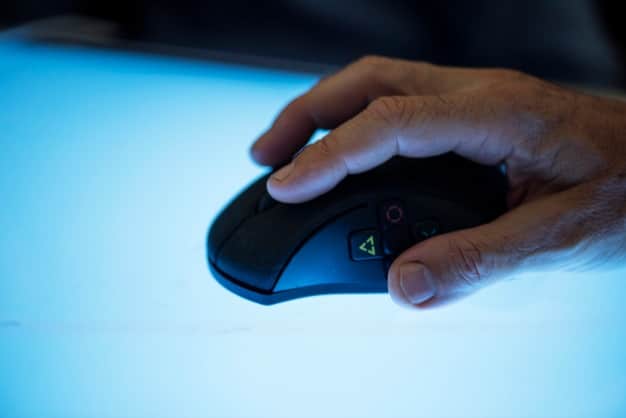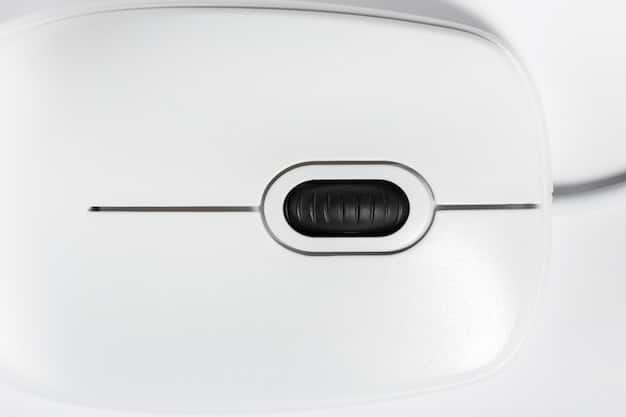Get the Edge: Upgrading Your Gaming Mouse for Improved Accuracy

Upgrading your gaming mouse is a strategic move to significantly enhance in-game performance, translating to superior aim, quicker reaction times, and a more immersive and competitive gaming experience.
In the relentless pursuit of competitive advantage within the gaming world, every millisecond and pixel matters. For dedicated gamers, the peripheral devices chosen can genuinely dictate the thin line between victory and defeat. This is where the crucial decision around your input devices, particularly your mouse, dramatically influences your performance. It’s not merely about having a fancy device; it’s about how that device empowers you to get the edge: upgrading your gaming mouse for improved accuracy, speed, and comfort.
The anatomy of a winning gaming mouse
Understanding what makes a gaming mouse superior to a standard office mouse is foundational to any meaningful upgrade. It goes beyond aesthetics or mere button count. The true value lies in the intricate technologies and ergonomic designs crafted to meet the stringent demands of high-stakes gaming environments. These mice are engineered from the ground up for precision, durability, and responsiveness, features that directly impact your in-game performance.
At the core of a gaming mouse lies its sensor. This is the “eye” of the mouse, detecting movement and translating it into cursor motion on your screen. High-quality optical or laser sensors offer exceptional tracking accuracy, ensuring that even the slightest movement of your hand is reflected precisely. The better the sensor, the more reliable your aim will be, which is paramount in fast-paced genres like first-person shooters (FPS) or real-time strategy (RTS) games.
Sensor technology and its impact
Modern gaming mice primarily use optical sensors, though some high-end models may still feature laser sensors. Optical sensors are generally preferred for their consistent tracking across various surfaces and their lack of acceleration, which can introduce unpredictable cursor movements. Laser sensors, while offering higher DPI, sometimes suffer from “sensor acceleration,” where cursor speed changes non-linearly with physical mouse movement. This can be detrimental to muscle memory and consistent aim.
Beyond the sensor, switches are another critical component. These are the mechanical mechanisms beneath the mouse buttons that register clicks. Gaming mice often employ durable, high-quality switches from reputable manufacturers like Omron, known for their tactile feedback and impressive lifespan, often rated for tens of millions of clicks. The consistency and responsiveness of these switches ensure that every command is registered instantly and reliably.
- DPI (Dots Per Inch): Higher DPI allows for faster cursor movement across the screen with less physical mouse movement, though true precision often favors moderate DPI setups combined with lower in-game sensitivities.
- Polling Rate: Measured in Hertz (Hz), this indicates how often the mouse reports its position to the computer. A 1000Hz polling rate means the mouse reports its position 1000 times per second (every 1ms), minimizing input lag.
- Acceleration/Deceleration: High-quality sensors aim for zero acceleration, ensuring that a physical mouse movement always translates to the same on-screen distance, regardless of the speed of the movement.
- Lift-Off Distance (LOD): This is the height at which the mouse stops tracking when lifted from the surface. A low LOD is preferable for competitive gamers who often “reposition” their mouse by lifting it, preventing unwanted cursor movement.
Ergonomics play a vital role in sustained comfort and performance. A mouse that fits your hand properly, accommodating your grip style (palm, claw, fingertip), reduces fatigue during long gaming sessions. Customizable weight systems, programmable buttons, and onboard memory for profiles further enhance the user experience, allowing gamers to tailor their peripheral to their specific needs and preferences. Ultimately, a winning gaming mouse is a harmonious blend of cutting-edge technology, meticulous design, and robust construction, all aimed at granting the player an undeniable edge.

Sensor sensitivity and its mastery: DPI, CPI, and IPS explained
When diving into the specifics of gaming mouse performance, understanding sensor sensitivity is paramount. It’s often simplified to “DPI,” but a deeper look reveals terms like CPI and IPS, each playing a critical role in how your mouse translates physical movement into on-screen action. Mastering these concepts is not about maxing out numbers, but about finding the optimal balance that suits your playstyle and desk space, directly impacting your in-game accuracy and responsiveness.
DPI, or Dots Per Inch, is the most commonly cited metric. It represents how many “dots” or pixels the cursor moves on screen for every inch the mouse moves physically. So, a 1600 DPI setting means the cursor moves 1600 pixels for every inch of mouse movement. While often used interchangeably, CPI (Counts Per Inch) is technically a more accurate term from the sensor’s perspective, referring to the number of counts the sensor registers per inch of movement, irrespective of screen resolution. For practical purposes, DPI and CPI are virtually identical in how they relate to the user experience.
Finding your ideal sensitivity
Contrary to popular belief, a higher DPI isn’t always better. Professional gamers often use relatively low DPI settings (e.g., 400-800 DPI) combined with lower in-game sensitivities. This allows for grand, sweeping movements on the mouse pad for precise aiming, relying on arm rather than wrist movements. This large range of motion offers finer control and less jitter, crucial for pinpoint accuracy in competitive titles.
- Lower DPI/CPI: Promotes arm aiming, leading to more stable and precise micro-adjustments, ideal for FPS games requiring pixel-perfect aiming.
- Higher DPI/CPI: Suitable for games requiring rapid cursor movement (e.g., RTS, MOBA), or for users with limited desk space. However, it can make fine adjustments challenging without careful calibration of in-game sensitivity.
- IPS (Inches Per Second): This metric measures the maximum speed at which a mouse can be moved before its sensor starts to lose tracking accuracy. High IPS values (e.g., 250-400 IPS) are crucial for players who make incredibly fast, sweeping movements, ensuring the sensor doesn’t “spin out” or malfunction during intense flick shots.
Experimentation is key to finding your ideal sensitivity. Start with a moderate DPI and adjust your in-game sensitivity until you can comfortably perform full 360-degree turns while still maintaining precision. Many pro gamers recommend an “eDPI” calculation (DPI x in-game sensitivity) for comparison across different games and setups. The goal isn’t to set the highest numbers, but to discover the “sweet spot” where your physical input perfectly translates to the desired on-screen outcome, providing an undeniable advantage in accurate and reliable aiming.
Unraveling the importance of polling rate and connectivity
Beyond sensor accuracy and sensitivity, two other critical factors significantly influence your gaming mouse’s responsiveness: polling rate and connectivity type. While often overlooked by casual users, a deep understanding of these elements can provide a tangible competitive advantage, minimizing input lag and ensuring that every twitch and click registers with split-second precision, directly contributing to improved accuracy and reaction times.
The polling rate, measured in Hertz (Hz), dictates how frequently your mouse reports its position to your computer. A standard office mouse might have a polling rate of 125 Hz, meaning it updates its position 125 times per second, or every 8 milliseconds. For competitive gaming, this delay is unacceptable. Most high-end gaming mice offer a 1000 Hz polling rate, translating to an update every 1 millisecond. This drastically reduces input lag, ensuring that what you see on screen is virtually instantaneous with your physical movement.
Wired vs. wireless: A perennial debate
The choice between wired and wireless connectivity has long been a contentious topic in the gaming community. Traditionally, wired mice were preferred due to their perceived lack of latency and immunity to interference. The direct USB connection guarantees a consistent, low-latency signal, making them a reliable choice for competitive play where every millisecond counts.
However, wireless technology has made immense strides in recent years. Modern gaming wireless mice often utilize proprietary 2.4 GHz wireless technologies, which offer latency comparable to, or even lower than, many wired counterparts. Technologies like Logitech’s LIGHTSPEED or Razer’s HyperSpeed achieve near-zero latency, effectively eliminating the traditional performance trade-off associated with wireless peripherals. Furthermore, the freedom from cables offers an unobstructed range of motion, which many gamers find beneficial for fluid, unhindered play.
- Wired Gaming Mice:
- Pros: Consistent, reliable, no battery concerns, generally more affordable.
- Cons: Cable drag can impede fluid movement, limited portability.
- Wireless Gaming Mice:
- Pros: Unrestricted movement, clean setup, enhanced portability.
- Cons: Battery life management, potential for minor interference (though rare with modern tech), often higher price point.
When selecting a wired mouse, look for models with braided cables that are flexible and include a cable tie to minimize drag. For wireless, prioritize models with dedicated USB-A dongles (avoid Bluetooth for gaming due to higher latency) and long battery life, often supporting fast charging or compatible with charging docks. Both polling rate and connectivity, whether wired or advanced wireless, are crucial considerations, ensuring your mouse keeps pace with your reflexes and delivers precise, real-time input that translates to enhanced accuracy and a superior gaming experience.
Ergonomics, weight, and grip styles: Tailoring your mouse to your hand
Beyond the technical specifications of sensors and polling rates, the tactile experience of a gaming mouse significantly impacts long-term performance and comfort. Ergonomics, the mouse’s weight, and how it accommodates your specific grip style are often underestimated factors that directly influence your ability to maintain accuracy and prevent fatigue during extended gaming sessions. A mouse that feels like an extension of your hand allows for more natural, consistent movements.
Gaming mice come in a vast array of shapes and sizes, each designed to cater to different hand forms and grip preferences. The three primary grip styles are palm, claw, and fingertip. Understanding your dominant grip style is the first step in selecting a mouse that provides optimal comfort and control. A palm grip involves the entire hand resting on the mouse, making it suitable for larger, more contoured mice that offer ample palm support. Claw grippers arch their fingers, making contact with the mouse only at the base of the palm and fingertips, often preferring medium-sized mice with a pronounced hump. Fingertip grippers use only their fingertips to control the mouse, favoring smaller, lighter, or ambidextrous designs for maximum freedom of movement.
Adjustable weight and balanced design
Many high-end gaming mice offer adjustable weight systems, allowing users to customize the mouse’s mass and even its balance. Adding or removing small weights can significantly alter the feel and responsiveness of the mouse. A heavier mouse might offer more stability for precise, slow movements, while a lighter mouse facilitates rapid, flick-shot maneuvers. The optimal weight is highly subjective and depends on individual preference, grip style, and game type.
- Palm Grip: Look for larger, ergonomically contoured mice that fill the hand completely, offering full palm support and often featuring a gentle slope.
- Claw Grip: Prefer mice with a prominent hump towards the back, allowing the palm to rest while the fingers arc for precise clicking and control, typically medium-sized.
- Fingertip Grip: Smaller, lighter, and often ambidextrous mice are ideal, providing minimal contact points for maximum maneuverability with just the fingertips.
- Ambidextrous Designs: Symmetrical shapes suitable for both left and right-handed users, though often lacking the contoured comfort of ergonomic right-handed mice.
Beyond shape and weight, surface materials also play a role. Some mice feature textured grips for enhanced stability, while others opt for smooth, matte finishes. The placement and tactile feedback of side buttons are also crucial, allowing for easy access to programmed macros without disrupting your grip. Ultimately, a gaming mouse should feel like a custom-fit tool, seamlessly integrating with your hand to provide natural, fatigue-free control, unlocking your full potential for accuracy and swift reactions in any gaming scenario.

Software customization and programmable buttons: Unleashing full potential
The raw hardware specifications of a gaming mouse provide the foundation for performance, but it’s the accompanying software that truly unlocks its full potential. Modern gaming mice come equipped with robust software suites that allow for extensive customization, transforming a powerful piece of hardware into a personalized extension of the player’s will. From remapping buttons to creating complex macros and managing performance profiles, this software is indispensable for competitive gamers seeking every possible advantage to improve accuracy and efficiency.
Programmable buttons are a cornerstone of this customization. Beyond the standard left, right, and scroll wheel clicks, many gaming mice feature additional buttons – often on the sides or top – that can be assigned a wide range of functions. In an FPS game, these might be bound to grenade throws, melee attacks, or quick weapon swaps. In an MMO, they could unleash a complex spell rotation with a single press. The ability to keep crucial commands within easy reach of your thumb or finger minimizes the need to move your hand to the keyboard, keeping your focus firmly on the action and enabling faster, more precise reactions.
Macros and performance profiles
Macros take button programming a step further. A macro is a sequence of commands, keystrokes, and mouse clicks recorded and assigned to a single button. For instance, a complex combo in a fighting game, a series of build orders in an RTS, or a rapid-fire burst in an FPS can all be executed instantly with a single click. This not only saves time but also ensures perfect execution of complex sequences, enhancing both speed and accuracy. The software typically provides an intuitive interface for recording, editing, and managing these macros.
- DPI Profile Switching: Instantly switch between multiple DPI settings, invaluable for precision aiming (low DPI) and rapid navigation (high DPI) within the same game.
- Button Re-mapping: Assign any mouse button to any keyboard key, macro, or multimedia function.
- Lighting Customization: Personalize RGB lighting effects to match your setup or game mood, often with integration into game-specific alerts.
- Surface Calibration: Optimize sensor performance for your specific mouse pad, ensuring consistent tracking across different surfaces.
Another powerful feature is the ability to create and save multiple performance profiles. These profiles can store unique settings for DPI, button assignments, macros, and lighting. Gamers can then link these profiles to specific applications or games, so the mouse automatically switches to the optimal configuration when a game is launched. This seamless transition ensures that your mouse is always perfectly tuned for the task at hand, whether it’s a high-octane shooter, a strategic online battle, or even productivity tasks. Leveraging the full capabilities of your mouse’s software is essential for truly customizing your device to your unique playstyle, offering a significant advantage in efficiency and precision.
Longevity and durability: Investing in quality components
For a gaming mouse, performance is paramount, but so is its ability to withstand the rigors of intense, prolonged use. Unlike casual peripherals, a gaming mouse is subjected to millions of clicks, rapid movements, and constant handling. Therefore, investing in a mouse built with high-quality components and a robust design is not merely a luxury; it’s a matter of ensuring longevity and consistent performance, preventing unexpected failures that can abruptly end a crucial match or undermine your hard-earned muscle memory.
The switches beneath the primary left and right-click buttons are often the first components to show wear. Reputable gaming mouse manufacturers predominantly use switches from companies like Omron, Kaihl, or Razer’s proprietary optical switches. These switches are rated for tens of millions of clicks (e.g., 20 million, 50 million, or even 70 million clicks), far exceeding the lifespan of standard office mouse switches. This high durability rating ensures that your clicks remain crisp, tactile, and responsive for years, without developing issues like double-clicking or missed inputs.
Build materials and cable reinforcement
The materials used in the mouse’s body and its internal construction also significantly contribute to its overall durability. High-quality plastics, often reinforced, provide a solid chassis that resists flex and creaks even under pressure. The scroll wheel, another heavily used component, should feel solid and perform consistently, ideally featuring a robust encoder for reliable step-by-step scrolling.
- Durable Switches: Look for mice with high click-life ratings (e.g., 50M+ clicks) from known brands like Omron. Optical switches are a newer, highly durable alternative as they lack physical contact points.
- Robust Chassis: A solid plastic or even aluminum frame prevents creaking and ensures the internal components are well-protected.
- Braided or Flexible Cables: For wired mice, a well-reinforced, flexible cable is crucial to resist fraying and damage from repeated bending, often a weak point in less durable designs.
- PTFE Feet (Mouse Skates): High-quality PTFE (Teflon) mouse feet ensure smooth, consistent glide and are more resistant to wear than cheaper plastic alternatives. Some mice even include replacement feet.
For wired mice, the cable itself is a critical point of potential failure. A well-designed gaming mouse will feature a durable, often braided, cable that is flexible enough to minimize drag but robust enough to withstand constant friction against the desk or mouse pad. The connection point where the cable enters the mouse should also be reinforced to prevent fraying and internal wire damage from bending. Investing in a mouse with superior components and thoughtful construction reduces the likelihood of premature failure and maintains peak performance over its lifespan. This reliability translates directly into an uninterrupted and consistently accurate gaming experience, making it a wise investment for any serious gamer.
Maintenance and optimization tips for peak performance
Even the most advanced gaming mouse requires proper care and regular optimization to maintain its peak performance and extend its lifespan. Neglecting simple maintenance routines can lead to reduced accuracy, inconsistent tracking, and premature wear, undermining your investment and competitive edge. A few straightforward practices can ensure your mouse continues to deliver precision and responsiveness day in and day out.
One of the most crucial aspects of mouse maintenance is keeping the sensor clean. Dust, hair, and debris can accumulate around the sensor lens, interfering with its ability to track accurately and leading to erratic cursor movements. Regularly (e.g., weekly) wiping the sensor area with a lint-free cloth or a cotton swab lightly dampened with rubbing alcohol can prevent this. For more stubborn dust, a can of compressed air can be used to gently blow away particles from the sensor opening.
Mouse pad matters and software updates
Your mouse pad is just as important as your mouse itself. A clean, smooth, and consistent surface is vital for optical and laser sensors to track effectively. A dirty or worn-out mouse pad can introduce friction, uneven glide, and interfere with sensor accuracy. Regularly clean your mouse pad according to its manufacturer’s instructions. For cloth pads, this might involve a gentle hand wash with mild soap and water, while hard pads can typically be wiped clean. Replace excessively worn or damaged pads to ensure an optimal tracking surface.
- Clean Your Mouse Pad: A clean surface ensures consistent glide and accurate sensor tracking.
- Keep Mouse Feet Clean: Accumulation of dirt on mouse feet can cause drag and inconsistent glide.
- Update Drivers/Firmware: Periodically check the manufacturer’s website for updated drivers and firmware for your mouse; these often include performance improvements, bug fixes, and new features.
- Optimize Software Settings: Regularly review your mouse software settings (DPI, polling rate, macros, profiles) to ensure they are optimized for the games you’re currently playing and your evolving playstyle.
Beyond physical cleanliness, software optimization plays a significant role. Regularly updating your mouse’s drivers and firmware, provided by the manufacturer, is essential. These updates often include important performance improvements, bug fixes, and compatibility enhancements that can refine sensor performance, reduce latency, and add new features. Additionally, periodically reviewing your mouse’s software settings (DPI profiles, button assignments, macros) ensures they remain optimized for your current gaming needs. Taking a few moments for these optimization and maintenance steps guarantees your gaming mouse operates at its peak, providing you with the reliable accuracy and responsiveness fundamental to a superior gaming experience. Investing in a quality mouse is only half the battle; maintaining it is how you truly get the edge.
| Key Aspect | Brief Description |
|---|---|
| 🎯 Sensor Quality | High-grade optical/laser sensors ensure precise tracking and consistent aim with zero acceleration for competitive gameplay. |
| ⚡ Polling Rate | A 1000Hz polling rate minimizes input lag (1ms reporting), crucial for rapid response times and real-time accuracy. |
| 🖐️ Ergonomics & Grip | Matching mouse shape and weight to your hand and grip style reduces fatigue and enhances control for sustained precision. |
| ⚙️ Software Customization | Programmable buttons and macros optimize workflow, allowing instant execution of complex commands for efficiency. |
Frequently asked questions about gaming mouse upgrades
▼
The sensor quality is arguably the most critical specification for accuracy. A high-quality optical or laser sensor with minimal acceleration, high IPS (Inches Per Second), and consistent tracking across various surfaces ensures that every physical movement is precisely translated on-screen, regardless of speed or direction, leading to superior aiming.
▼
No, a higher DPI isn’t always better. While it allows for faster cursor movement with less physical effort, it can make fine adjustments difficult. Many professional gamers prefer lower DPI settings (e.g., 400-800 DPI) combined with lower in-game sensitivities, which promotes more precise arm aiming over quick but less stable wrist movements.
▼
For competitive play, modern wireless gaming mice using proprietary 2.4 GHz technologies (like Logitech’s LIGHTSPEED or Razer’s HyperSpeed) offer latency comparable to wired options, providing freedom of movement without performance compromise. However, wired mice remain excellent due to their guaranteed zero interference and no battery concerns.
▼
Mouse ergonomics are extremely important for sustained performance and preventing fatigue. A mouse that fits your hand and grip style (palm, claw, or fingertip) correctly reduces strain during long gaming sessions, allowing for more consistent and comfortable movements, which directly contributes to maintaining accuracy over time.
▼
Regular maintenance includes cleaning the sensor lens and mouse feet to prevent tracking issues and drag, respectively. Additionally, keeping your mouse pad clean is crucial for consistent tracking. Periodically updating mouse drivers and firmware from the manufacturer’s website also ensures optimal performance and access to the latest features and bug fixes.
Conclusion
Ultimately, upgrading your gaming mouse is an investment in your performance, precision, and overall gaming satisfaction. It’s a strategic move that goes far beyond cosmetic appeal, delving deep into the technical intricacies of sensor precision, responsiveness, and ergonomic comfort. By carefully considering factors such as sensor quality, polling rate, an appropriate ergonomic design for your grip, and leveraging powerful software customization, you can truly tailor your input device to your unique playstyle. This detailed approach not only enhances your in-game accuracy and reaction times but also ensures endurance and consistency across countless hours of intense gameplay, giving you the definitive edge in any competitive virtual arena.





